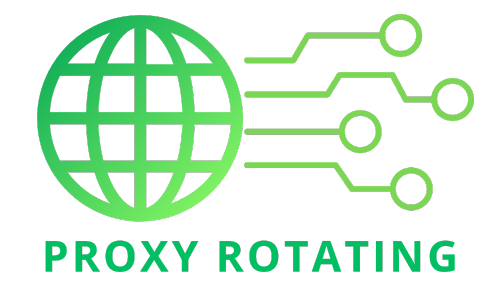The blockchain security testing checklist is a series of steps to assess a blockchain’s security, ensuring protection against attacks and other threats. Understanding this checklist and its benefits is crucial for efficiently evaluating and utilizing supporting tools. To delve deeper into these topics, follow the Proxy Rotating article below.
What is a blockchain security testing checklist?
A blockchain security testing checklist is designed to ensure the security and integrity of blockchain applications. It encompasses a series of checks and procedures to identify vulnerabilities, assess risk levels, and verify the implementation of blockchain technologies’ security measures. Here’s a general overview of the components that might be included in such a checklist:
Smart contract audits
– Code review: Review the smart contract code for common vulnerabilities (e.g., reentrancy, overflow/underflow, gas limit issues).
– Dependency checks: Analyze dependencies for known vulnerabilities.
– Logic verification: Ensure the business logic implemented in the contract aligns with the intended functionality.
Network security
– Node security: Assess the security of individual nodes against unauthorized access and other vulnerabilities.
– Consensus mechanisms: Evaluate the resilience of the Blockchain’s consensus mechanism against attacks such as 51% attacks.
– Network privacy: Verify the mechanisms in place to ensure the confidentiality of transactions.

Access controls
– Authentication and authorization: Ensure robust mechanisms for authenticating and authorizing entities.
– Permissions: Verify that permissions are correctly implemented and enforced for accessing various parts of the blockchain system.
Cryptography
– Key management: Assess the processes in place for managing cryptographic keys.
– Encryption practices: Verify the use of encryption for data at rest and in transit.
– Cryptographic algorithms: Ensure strong and widely accepted cryptographic algorithms are used.
Governance and compliance
– Regulatory compliance: Check for compliance with relevant regulations (e.g., GDPR for personal data).
– Governance model: Evaluate the governance model for managing changes to the blockchain application.
Operational security
– Backup and Recovery: Assess the mechanisms in place for data backup and recovery.
– Incident response plan: Ensure an incident response plan for security breaches exists.
Front-end application security (for DApps)
– Web security: Apply best practices to protect users from common vulnerabilities (e.g., XSS, CSRF).
– User authentication: Implement secure user authentication mechanisms.
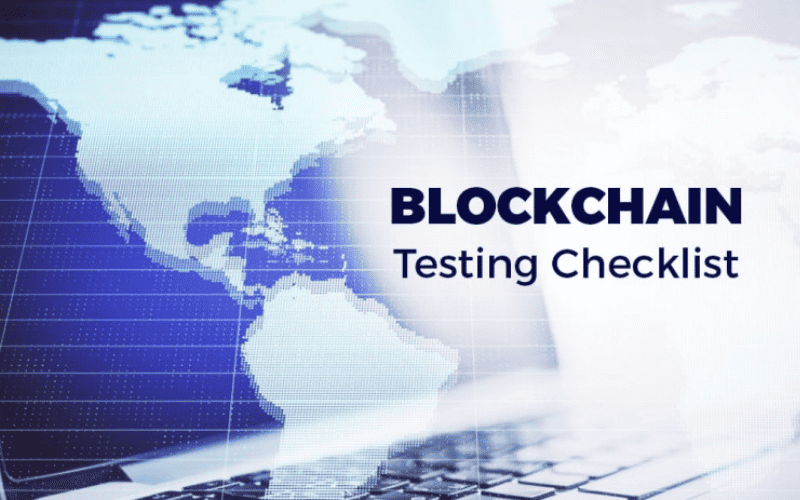
Testing for interoperability and integration
– External interfaces: Test the security of interfaces and integrations with external systems and services.
– Cross-Chain transactions: Evaluate the security of cross-chain transaction mechanisms if applicable.
Performance and stress testing
– Throughput testing: Assess the system’s ability to handle high volumes of transactions.
– Stress testing: Test the system under extreme conditions to identify potential points of failure.
Privacy considerations
– Anonymity: Verify the measures to ensure user anonymity where applicable.
– Data minimization: Assess practices for minimizing the amount of personal data stored on the Blockchain.
This checklist is a starting point and may need to be adapted based on the specific blockchain technology, application, or platform being tested. Security testing should be conducted by experienced professionals and complemented by third-party audits to ensure comprehensive coverage.
Types of Blockchain Security Testing Checklist
Blockchain security testing can be broadly divided into general and specific checklists, each addressing different aspects and levels of the blockchain ecosystem. Here’s an outline of what each type typically includes:
General security checklist
The general security checklist for Blockchain encompasses tests that apply to various blockchain architectures and applications. This checklist covers the foundational security measures any blockchain system should implement, regardless of its specific use case. Key areas include:
- Smart contract security:
– Syntax and semantic checks: Basic code quality and logic checks to prevent common vulnerabilities.
– Dependency security: Analysis of third-party contracts or libraries for known issues.
- Consensus mechanisms:
Analyse consensus protocol security to prevent attacks leading to forks or consensus disruption.
- Network security:
– Node communication: Encryption and secure communication channels between nodes.
– Peer-to-peer network testing: Checks against Sybil, eclipse, and other network-based attacks.
- Cryptography practices:
– Key management: Secure generation, storage, and recovery of cryptographic keys.
– Encryption standards: Use of industry-standard algorithms and protocols.
- Access control and authentication:
– Multi-factor authentication: Implementation of robust authentication mechanisms.
– Role-based access control: Ensuring proper access control policies are in place.
- Data privacy and protection:
– Data at rest encryption: Encrypting stored data to protect against unauthorized access.
– Data anonymization: Techniques to anonymize sensitive data where necessary.
- Governance and compliance:
– Regulatory compliance: Checks for adherence to legal and regulatory requirements.
– Smart contract governance: Processes for updating and managing smart contracts.
- Operational security:
– Incident response planning: Preparedness for addressing security incidents.
– Audit and logging: Adequate logging of activities for monitoring and forensic analysis.
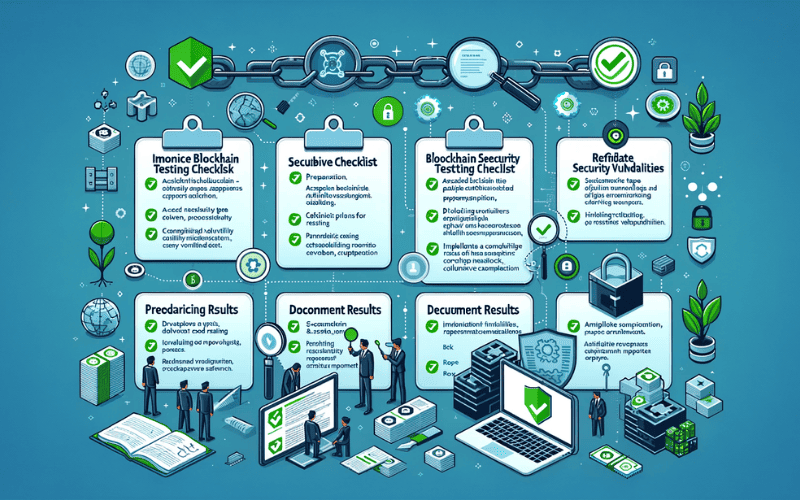
Specific security checklist
Specific security checklists are tailored to address different blockchain systems’ unique security requirements and vulnerabilities, such as public, private, and consortium blockchains or specific applications like DEFI platforms, NFT marketplaces, and supply chain solutions. These checklists dive deeper into the nuances of each application, focusing on:
- Application-specific smart contract audits:
– Focused audits on the business logic and specific functionalities of intelligent contracts related to the application.
- Custom consensus protocol testing:
– Security testing of customized or less common consensus mechanisms unique to the Blockchain.
- Third-party integrations and oracles:
– Security verification of external data sources and integration points specific to the blockchain application.
- User interface and experience:
– security checks on the application’s front end, especially for DApps, to prevent phishing, MITM attacks, and other web-based vulnerabilities.
- Specific regulatory compliance:
– Detailed compliance checks tailored to the application’s industry or sector, such as finance (KYC/AML) or healthcare (HIPAA).
- Advanced cryptography features:
– Zero-knowledge proofs, multi-signature schemes, and other advanced cryptographic features specific to the application’s needs.
- Custom governance models:
– Evaluation of unique governance structures and mechanisms for decision-making and updates within the blockchain ecosystem.
- Specialized operational security measures:
– Security operations specific to the application, including custom monitoring tools, specialized incident response strategies, and advanced threat detection systems.
Each checklist is developed considering the unique aspects and threat models of the blockchain system or application, requiring a deep understanding of its architecture, functionality, and use case. These tailored checklists ensure that security testing is relevant, thorough, and effective for the specific blockchain environment.
Benefits of using a blockchain security testing checklist
Using a blockchain security testing checklist offers several advantages that enhance the effectiveness and efficiency of security assessments within the blockchain ecosystem. Here are the key benefits:
Time-saving
- Streamlined process: A well-structured checklist guides testers through the assessment process, helping them identify which tests to perform and in what order. This streamlines the assessment process, reducing the time required to evaluate blockchain applications and infrastructure security.
- Task prioritization: Checklists can help prioritize security tasks based on the risk and impact of potential vulnerabilities. This allows security teams to focus their efforts on the most critical areas first, ensuring efficient use of time and resources.
Comprehensive assurance
- Holistic security evaluation: A comprehensive checklist ensures that all aspects of blockchain security are considered, from smart contract vulnerabilities to network security and consensus mechanism integrity. This holistic approach helps identify potential security gaps that might be overlooked if a more ad hoc approach were taken.
- Consistent standards: Using a checklist ensures that every security assessment adheres to a consistent standard, making it easier to compare and track the security posture of different blockchain projects or the same project over time.
Improved accuracy
- Minimized human error: A structured checklist helps reduce the risk of human error during security assessments. By providing a clear set of items to verify, checklists help ensure that security analysts recognize and remember to check specific vulnerabilities or security measures.
- Enhanced detail orientation: Checklists encourage a detail-oriented approach to security assessments. This means that even seemingly minor or obscure vulnerabilities are checked, reducing the likelihood of “blind spots” in the security evaluation.
Additional benefits
- Facilitation of regulatory compliance: Many blockchain applications operate in regulated industries. A checklist can include specific regulatory compliance checks, making it easier for organizations to meet legal and industry standards.
- Knowledge sharing and skill building: Checklists can be shared within and between organizations, promoting best practices and helping to build a shared understanding of blockchain security issues. They serve as educational tools for new team members, enhancing their knowledge of potential security concerns in blockchain systems.
- Flexibility and scalability: Checklists can be adapted and expanded to meet the evolving landscape of blockchain technology and emerging threats. This flexibility ensures that security assessments remain relevant and comprehensive as new vulnerabilities are discovered and blockchain applications are complex.
Overall, using a blockchain security testing checklist can significantly enhance the security posture of blockchain projects by providing a systematic approach to identifying and mitigating security risks.
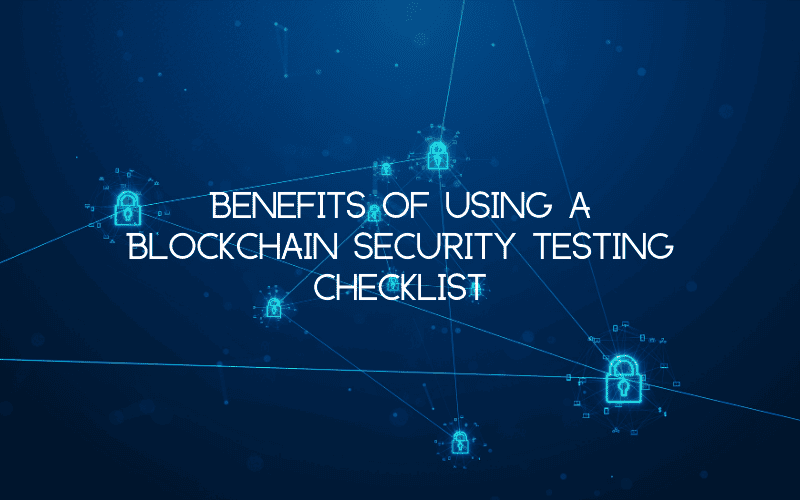
Implementation steps for using a blockchain security testing checklist
Implementing a blockchain security testing checklist is a structured approach to identifying and mitigating potential security vulnerabilities in blockchain applications and infrastructure. Here’s a detailed guide on how to effectively implement such a checklist:
Step 1: Identify a suitable checklist
- Assess your blockchain type: Determine whether you’re working with a public, private, or consortium blockchain, as each has unique security considerations.
- Understand your application: Consider the specific features of your blockchain application, such as smart contracts, decentralized apps (apps), or financial transactions. This understanding will guide you in selecting a checklist that addresses all relevant security aspects.
- Research and select: Look for existing checklists that security experts, organizations, or within the blockchain community have developed. Choose one that is comprehensive and aligns with the type of blockchain technology and application you assess.
Step 2: Execute checklist steps
- Preparation: Before you begin, ensure you have access rights, tools, and resources to perform the security assessment. This may include code analysis tools, intelligent contract audit platforms, and network scanning tools.
- Systematic execution: Proceed through the checklist systematically, executing each step carefully. This may involve code review, network testing, access control verification, etc.
- Involve experts: Consider involving security experts, especially for complex areas such as smart contract logic and cryptographic implementations. Their expertise can be invaluable in identifying subtle vulnerabilities.
Step 3: Document results
- Record findings: For each item on the checklist, document your findings, including any vulnerabilities identified, their potential impact, and the risk level. Be thorough in your documentation to ensure that everything is noticed.
- Create a report: Compile your findings into a comprehensive security assessment report. This report should summarize the vulnerabilities found, their severity, and recommended remediation actions.
- Feedback loop: Share the report with relevant stakeholders, including development teams, security personnel, and management. Encourage feedback to ensure that all perspectives are considered when interpreting the results.
Step 4: Remediate security vulnerabilities
- Prioritize based on risk: Prioritize vulnerabilities based on their potential impact and the likelihood of exploitation. Address high-risk vulnerabilities first.
- Develop a remediation plan: Outline a plan for remediation for each vulnerability. This may involve code changes, configuration updates, or the implementation of additional security controls.
- Implement changes: Work with the development and security teams to implement the necessary changes. Ensure that changes are tested thoroughly before being deployed to production.
- Re-assessment: After remediation, re-assess the affected areas to ensure that vulnerabilities have been effectively addressed. This may involve revisiting specific items on the checklist.
- Continuous improvement: Use the insights gained from the security assessment to improve your security practices. Update your checklist and processes to address new threats and vulnerabilities as they emerge.
Implementing a blockchain security testing checklist is an ongoing process. It requires continuous vigilance, regular updates to the checklist, and a commitment to security best practices to protect against evolving threats in the blockchain ecosystem.
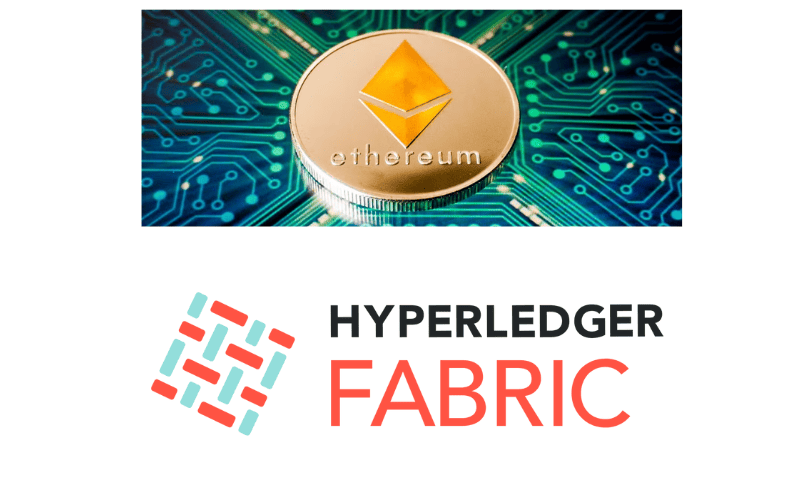
Example of blockchain security testing checklist:
An example of a blockchain security testing checklist can be divided into two primary categories: a general security checklist that applies across various blockchain platforms and technologies and specific security checklists tailored to particular blockchain frameworks such as Ethereum and Hyperledger fabric. Each checklist includes focused tasks designed to uncover vulnerabilities and strengthen the security posture of the blockchain application or infrastructure.
1.General security checklist
- Source code review
Review for common vulnerabilities: Look for reentrancy, integer overflow/underflow, and improper error handling.
Coding standards compliance: Check that the code adheres to established coding standards and best practices for readability and security.
Dependencies analysis: Identify and assess the security of third-party libraries and dependencies.
- Configuration review
Node configuration: Verify that blockchain nodes are configured securely, with unnecessary services disabled.
Network configuration: Check network settings to ensure secure communication between nodes.
Cryptography configuration: Ensure that cryptographic settings (e.g., key lengths, algorithms) are up to standard.
- Penetration testing
Network level testing: Simulate attacks against the network to identify vulnerabilities like exposed ports or services.
Brilliant contract manipulation: Attempt to exploit smart contracts through various attack vectors to uncover vulnerabilities.
Access control testing: Test for weaknesses in authentication and authorization mechanisms.
- Tool analysis
Static analysis tools: Use static analysis tools to scan code for vulnerabilities automatically.
Dynamic analysis tools: Deploy dynamic analysis to evaluate the blockchain application in a running state.
Compliance tools: Utilize tools designed to check for compliance with regulatory and security standards.
- Specific security checklist
- Security Checklist for Ethereum
Smart contract audits: Conduct thorough audits of smart contracts using tools like Mythril, slither, or Security.
Gas usage analysis: Analyze contracts for potential gas limit issues that could lead to denial of service.
Decentralized application (DApp) security: Review the security of DApps, focusing on web interface vulnerabilities and the handling of private keys.
- Security Checklist for Hyperledger Fabric
Chaincode Security: Like intelligent contract audits, review chain code (hyper ledger’s equivalent of smart contracts) for vulnerabilities.
Channel configuration: Verify the security of channel configurations, ensuring that private data is adequately protected.
Endorsement policy compliance: Ensure that endorsement policies are correctly implemented to validate transactions.
This example provides a foundation for building comprehensive blockchain security testing protocols. Adapting and expanding these checklists based on your blockchain project’s specific features, functionalities, and risks is essential. Continuous updating and customization of the checklist are crucial as new vulnerabilities are discovered and blockchain technologies evolve.
Supporting tools for blockchain security testing
Supporting tools for blockchain security testing play a crucial role in identifying vulnerabilities, auditing intelligent contracts, and ensuring the overall security of blockchain applications. Here’s a rundown of some of the most commonly used tools in the field:
Smart contract analysis tools
- Mythril: An open-source security analysis tool for Ethereum smart contracts. It performs static analysis to detect security vulnerabilities, inefficiencies, and other issues in smart contracts.
- Slither: A Solidity static analysis framework that can detect vulnerabilities, enhance code understanding, and automate code review. It is designed to help developers write more secure code on the Ethereum platform.
- Oyente: An analysis tool that can explore and detect common vulnerabilities in Ethereum smart contracts. It uses symbolic execution to analyze the bytecode of the contracts.
- Security is a formal verification tool for Ethereum smart contracts. It scans contracts for vulnerabilities and certifies their security against a comprehensive set of security properties.
Network security tools
- Nmap is a network scanner used to discover hosts and services on a computer network, thereby building a “map” of the network. While not blockchain-specific, it’s useful for assessing the security of blockchain nodes and networks.
- Wireshark is a network protocol analyzer that can capture and display data traveling back and forth on a network in real-time. It is valuable for analyzing the data flow in blockchain networks.
- Metasploit: While primarily used for penetration testing, Metasploit can be adapted to test blockchain networks’ resilience against various attack vectors.
Penetration testing frameworks
- Burp suite: A tool for performing security testing of web applications, it can also be used for decentralized applications (DApps) that interact with blockchain backends.
- OWASP ZAP (Zed Attack Proxy): An open-source web application security scanner that helps find vulnerabilities in web applications and APIs that are part of the blockchain ecosystem.
Cryptography analysis tools
- Cryptool: Offers a comprehensive collection of cryptographic algorithms and provides visualizations of their workings, which help understand and validate the cryptographic practices used in blockchain applications.
- Hashcat is an advanced password recovery tool that can test the strength of cryptographic hashes used within blockchain systems.
Compliance and governance
- Quantstamp: A protocol for securing smart contracts that provides automated security checks and manual audits, helping ensure compliance with security standards.
- ChainSecurity: Offers a platform for automated security audits of smart contracts, providing insights into potential security issues and compliance risks.
Tools for general security assessment
- Kali Linux is a Linux distribution designed for digital forensics and penetration testing. It contains a suite of tools for attacking and testing the security of blockchain systems.
- Geth & Parity (for Ethereum): While primarily Ethereum client software, Geth and Parity include tools and functionalities for testing and analyzing the security of Ethereum-based applications.
These tools are part of a broader ecosystem of blockchain security resources. Developers and security professionals should select tools based on the specific requirements of their blockchain platform and application to ensure comprehensive security testing.
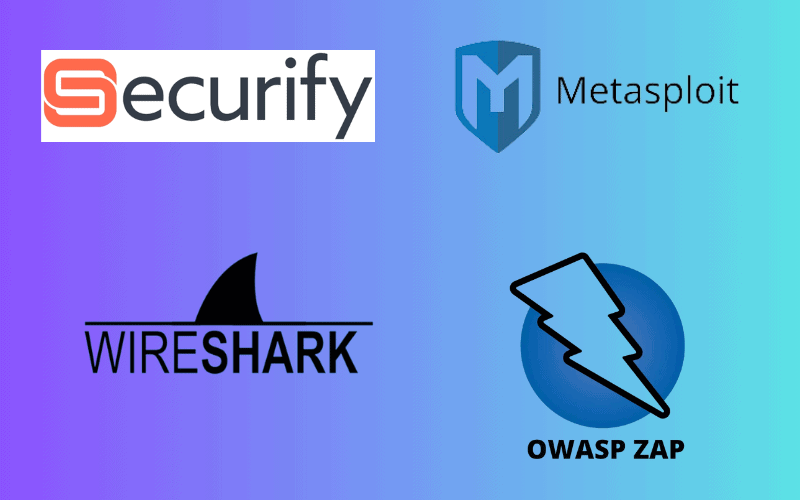
Service providers for blockchain security testing
Several firms specialize in blockchain security testing, offering services from smart contract audits to full-scale blockchain network security assessments. These service providers leverage cryptography, blockchain technology, and cybersecurity expertise to help organizations identify vulnerabilities, secure their blockchain applications, and comply with regulatory standards. Here’s a list of notable service providers in the blockchain security space:
Quantstamp
- Services offered: Quantstamp provides intelligent contract audits, security consulting for blockchain products, and a decentralized security network for automating security checks on Ethereum smart contracts.
- Notable features: Utilizes automated tools and manual review processes to ensure thorough, smart contract audits.
Trail of bits
- Services offered: Security assessments, smart contract audits, and blockchain platform reviews are presented. Trail of Bits is known for its deep technical expertise in cybersecurity, providing services beyond standard vulnerability checks.
- Notable features: Employs cutting-edge security research to inform its audits and security assessments.
Consensys diligence
- Services offered: This company specializes in smart contract audits and blockchain security consulting. As part of the ConsenSys ecosystem, it has particular expertise in Ethereum and offers tools like MythX for automated security analysis of Ethereum smart contracts.
- Notable features: Offers comprehensive, innovative contract audit services, leveraging extensive experience in Ethereum-based projects.
Chain Security
- Services offered: Chain Security provides automated security audits for intelligent contracts, focusing on identifying security weaknesses before they can be exploited. It also offers compliance checks to ensure intelligent contracts meet regulatory and industry standards.
- Notable features: Utilizes formal verification methods to provide in-depth security analysis.
Hacken
- Services offered: Hacken offers cybersecurity services tailored to the blockchain industry, including smart contract audits, penetration testing, and security consulting.
- Notable features: Hacken’s approach combines automated scanning with manual review to ensure thorough analysis.
Celtic
- Services offered: Certik specializes in Blockchain and smart contract verification using formal verification technology. It provides security audits, penetration testing, and blockchain protocol security verification.
- Notable features: Leverages Skynet, a real-time security monitoring tool, and the Certik security leaderboard to provide transparency on the security status of blockchain projects.
Openzeppelin
- Services offered: Known for its secure, community-vetted smart contracts, Openzeppelin offers security audits and consulting services for blockchain applications. It also provides development tools and libraries to help build secure smart contracts.
- Notable features: Openzeppelin’s security library is widely used in the blockchain community to develop secure smart contracts.
Blockchain app factory
- Services offered: Provides various blockchain services, including security audits, innovative contract development, and end-to-end blockchain development. Their security services aim to identify vulnerabilities in blockchain applications and ensure regulatory compliance.
- Notable features: Offers customized blockchain solutions and security services tailored to client needs.
These service providers play a crucial role in the blockchain ecosystem, offering the expertise needed to navigate the complex landscape of blockchain security. Organizations looking to secure their blockchain applications should consider partnering with specialized security firms to leverage their deep technical knowledge and comprehensive security services.
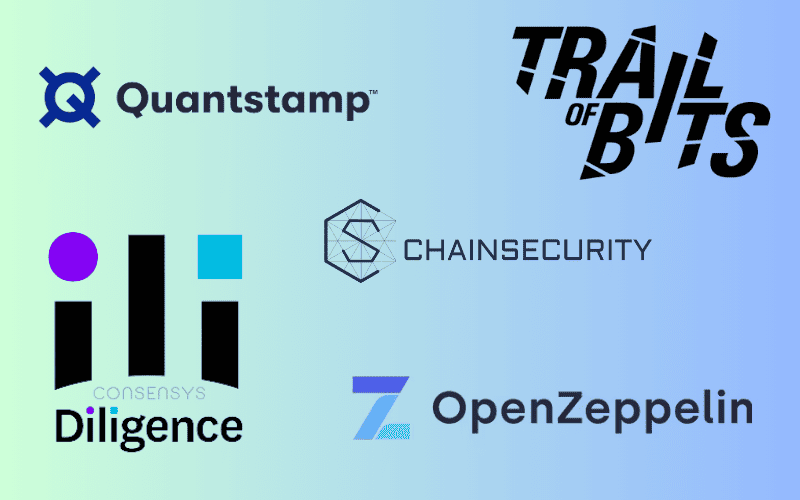
Costs of blockchain security testing
The costs of blockchain security testing can vary widely based on several factors, including the complexity of the blockchain application, the depth of the security audit required, the reputation and expertise of the service provider, and the specific services needed. Here’s a breakdown of some key factors that influence cost:
- Complexity of the application
- Smart contracts and DApps: Applications with numerous or complex intelligent contracts will require more thorough testing, increasing costs. Auditing simple projects might cost a few thousand dollars while auditing more complex systems could cost tens of thousands.
- Custom blockchain implementation: Projects that use custom blockchain solutions or heavily modified existing blockchains can expect higher testing costs due to the increased effort required to understand and evaluate the customized components.
- Depth of the audit
- Automated vs. Manual audits: Automated audits are generally less expensive but might only catch some potential issues. Manual audits, especially those that require significant expertise, can be much more costly but offer a deeper analysis.
- Reputation and expertise of the auditor: High-profile auditors or firms with a strong track record in blockchain security can command higher prices due to their knowledge and the demand for their services.
- Type of services required
- Smart contract audits: Basic audits might start in the low thousands of dollars, but comprehensive audits for complex contracts can easily reach the tens of thousands.
- Penetration testing and network security: Depending on the scope, penetration tests can cost anywhere from a few thousand to over $50,000 for extensive testing of large, complex systems.
- Compliance checks: If the audit includes compliance checks against specific regulations (e.g., GDPR, HIPAA), this can add to the cost due to the extra expertise and effort required.
- Urgency
- Rush jobs: Projects requiring a quick turnaround might incur additional costs. Firms often charge a premium for expedited audits due to the extra resources and overtime work needed to meet tight deadlines.
General cost estimates
Security audits can range from $5,000 to $20,000 for small to medium-sized projects.
Larger projects, especially those requiring in-depth analysis of complex, intelligent contracts or custom blockchain implementations, can exceed $50,000.
High-end security consulting firms and top-tier auditors might charge significantly more, especially for comprehensive services, including manual auditing, penetration testing, and ongoing security monitoring.
Blockchain projects must factor in the cost of security testing as part of their development budget. Skipping or skimping on security audits can lead to vulnerabilities that might cost significantly more to address after they are exploited or cause a loss of user trust. Investing in thorough security testing upfront can save money and prevent reputational damage in the long run.
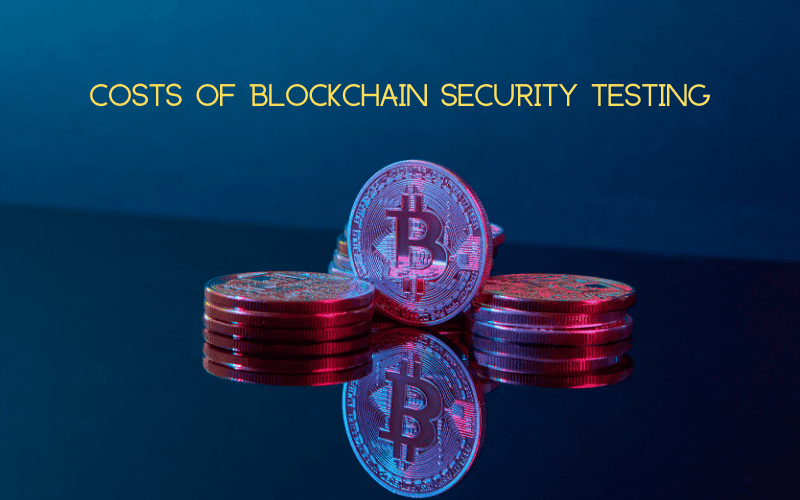
In summary, the article provided information about the blockchain security testing checklist. The specific lists make the checklist highly beneficial. Leveraging the checklist’s benefits will help you assess blockchain security comprehensively. If you are interested in Blockchain-related information, please visit the website https://proxyrotating.com to explore more.
>>> See more:
Blockchain security testing tools
Blockchain security in cloud computing
